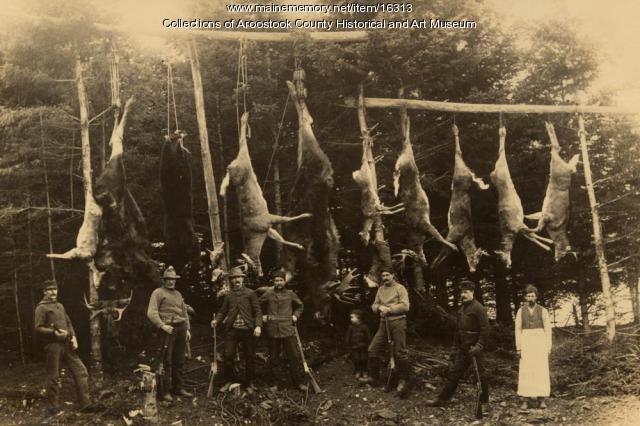Keywords: Art Work of Aroostook County, Maine
Item 10883
Scene on the Aroostook River, Ashland, ca. 1890
Contributed by: Aroostook County Historical and Art Museum Date: circa 1890 Location: Ashland Media: Photographic print
Item 10857
Bangor and Aroostook Railroad bridge, Presque Isle, ca. 1893
Contributed by: Aroostook County Historical and Art Museum Date: circa 1893 Location: Presque Isle Media: Photographic print
Exhibit
Holding up the Sky: Wabanaki people, culture, history, and art
Learn about Native diplomacy and obligation by exploring 13,000 years of Wabanaki residence in Maine through 17th century treaties, historic items, and contemporary artworks—from ash baskets to high fashion. Wabanaki voices contextualize present-day relevance and repercussions of 400 years of shared histories between Wabanakis and settlers to their region.
Exhibit
Shepard Cary: Lumberman, Legislator, Leader and Legend
Shepard Cary (1805-1866) was one of the leading -- and wealthiest -- residents of early Aroostook County. He was a lumberman, merchant, mill operator, and legislator.
Site Page
Aroostook Historical and Art Museum
View collections, facts, and contact information for this Contributing Partner.
Site Page
Presque Isle: The Star City - Working in Maine
"1900Aroostook County Historical and Art Museum Percival Baxter and Katahdin, ca. 1962Baxter State Park Del worked for the State of Maine in…"
Story
Becoming Master snowshoe makers
by Edmond and Brian J. Theriault
Making snowshoes has taken us from novices to world-class craftsmen over 40 years time.
Lesson Plan
Longfellow Studies: "Evangeline: A Tale of Acadie"--Selected Lines and Illustrations
Grade Level: 6-8, 9-12
Content Area: Social Studies, Visual & Performing Arts
Henry Wadsworth Longfellow, Maine's native son, is the epitome of Victorian Romanticism. Aroostook County is well acquainted with Longfellow's epic poem, Evangeline, because it is the story of the plight of the Acadians, who were deported from Acadie between 1755 and 1760. The descendants of these hard-working people inhabit much of Maine, New Brunswick, and Nova Scotia.
The students enjoy hearing the story and seeing the ink drawings. The illustrations are my interpretations. The collection took approximately two months to complete. The illustrations are presented in a Victorian-style folio, reminiscent of the family gathered in the parlor for a Sunday afternoon reading of Evangeline, which was published in 1847.
Preparation Required/Preliminary Discussion:
Have students read "Evangeline A Tale of Acadie". Give a background of the Acadia Diaspora.
Suggested Follow-up Activities:
Students could illustrate their own poems, as well as other Longfellow poems, such as: "Paul Revere's Ride," "The Village Blacksmith," or "The Children's Hour."
"Tales of the Wayside Inn" is a colonial Canterbury Tales. The guest of the inn each tell stories. Student could write or illustrate their own characters or stories.
Appropriate calligraphy assignments could include short poems and captions for their illustrations. Inks, pastels, watercolors, and colored pencils would be other appropriate illustrative media that could be applicable to other illustrated poems and stories. Each illustration in this exhibit was made in India ink on file folder paper. The dimensions, including the burgundy-colors mat, are 9" x 12". A friend made the calligraphy.











